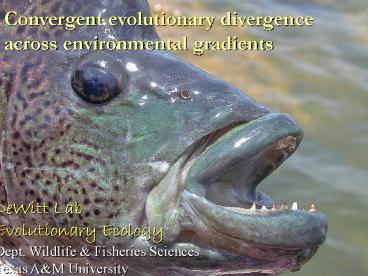Natural Selection and Emergent Impacts of Multiple Predators - PowerPoint PPT Presentation
1 / 28
Title:
Natural Selection and Emergent Impacts of Multiple Predators
Description:
Predator-associated divergence in G. affinis. New powers of visualization! ... Do predator-assoc. shapes come with a cost? Higher endurance swimming. ... – PowerPoint PPT presentation
Number of Views:64
Avg rating:3.0/5.0
Title: Natural Selection and Emergent Impacts of Multiple Predators
1
Convergent evolutionary divergence across
environmental gradients
DeWitt Lab Evolutionary Ecology Dept. Wildlife
Fisheries Sciences Texas AM University
2
One question From whence did organic diversity
arise?
Explanation 1 It arose spontaneously from the
ashes as the mythical phoenix.
Explanation 2 Stochastic and deterministic
ecological factors drove (and are driving still)
the evolution of alternative forms.
3
One constant in the universe things change
(and environmental change is the stuff of
creation)
A consequence of environmental change is that
organisms adapted to any one environment soon
find themselves in another
4
Road Map to the Talk
I. Predator gradients A. Gambusia affinis
(Texas, USA) B. Gambusia hubbsi (Bahamas) C.
Poecilia reticulata (Trinidad) D. Brachyrhaphis
rhabdophora (Costa Rica) E. Pseudocrenilabrus
multicolor (Uganda)
II. Other (flow, diet and habitat structure
gradients) A. Biotodoma wavrini (Venezuela)
B. Bryconops caudomaculatus (Venezuela) C.
Leiostomus xanthurus (Gulf of Mexico) D.
Gambusia affinis (Texas, USA)
5
I. Predator gradients A. Predator gradient in
Gambusia affinis (Texas, USA)
Gambusia affinis (Mosquitofish)
Green
Bluegill
Bass
6 populations - 3 with predators - 3
without predators 410 individuals
Longear
6
How we measured body shape
- Capture images of organism
- Digitize landmarks
3
2
10
4
5
1
7
6
8
9
- Use geometric morphometrics to analyze and
visualise - shape change across predator gradients
7
Predator-associated divergence in G. affinis
Males
2
95 confidence centroids
NP1 NP2
NP3
P3 P2 P1
P1
NP1
P3
NP2 NP3
P2
Females
1
-3
-2
-1
0
1
2
3
Predator Effect Canonical Axis
MANCOVA results Predator regime, Population
(Predator regime) P lt 0.0001
8
New powers of visualization!
Predator-free
Predators
Exaggerated caudal region, smaller body/head,
more elongate with predators
Using canonical scores from MANCOVA magnified 3X.
9
Functional consequences?
- Do predator-assoc. shapes enhance escape ability?
- Increases escape scores
- Canonical scores velocity distance
- (R2 0.39, P 0.023, N 13)
- Do predator-assoc. shapes come with a cost?
- Higher endurance swimming.
- Canonical scores endurance swimming
- (R2 0.38, P 0.024, N 13)
Performance trials by David Gonzales and Mark Belk
10
I. Predator gradients B. Predator gradient in
Gambusia hubbsi (Bahamas)
Atlantic needlefish
Gambusia hubbsi
Great barracuda
2 populations
Tarpon
11
I. Predator gradients C. Predator gradient in
Poecilia reticulata (Trinidad)
Crenicichla
Poecilia reticulata (Guppy)
Astyanax
4 populations - 2 with predators - 2
without predators
Hemibrycon
12
Morphological Divergence
95 confidence centroids
G. affinis
P
NP
P
NP
MANCOVA Predator regime, P lt 0.0001 Pop
(Pred regime), P lt 0.0001 DFA 72
correct
G. hubbsi
NP
P
P. reticulata
Predator Effect Canonical Axis
(29 of shape variance)
13
Shared and unique partitioning
Using species-free residuals
MANCOVA Predator regime P lt 0.0001 Pop (Pred.
regime) P lt 0.0001
Denied! ?
Submitted to American Naturalist
14
But they liked the idea, so
- We threw out all the data
- We collected new fish
- We changed our morphometric methods
- We changed our statistical model
- We changed guppies for Brachyraphis
15
I. Predator gradients D. Predator gradient in
Brachyrhaphis rhabdophora (Costa Rica)
Parachromis dovii
Rhamdia sp.
Brachyrhaphis rhabdophora
16
Shared and unique partitioning
Shared predator response
(all 3x)
Shared predator-free response
17
I. Predator gradients E. Predator gradient in
Pseudocrenilabrus multicolor (Uganda)
Nile perch
P. multicolor
(Predatorius horribilis)
18
Predator-associated divergence in P. multicolor
(3)
Lakes without Nile perch
Lakes with Nile perch
Averaged image
In collaboration with Lauren Chapman (U. Florida)
19
II. Other (flow, diet and habitat structure
gradients) A. Flow gradient in B.
caudomaculatus
B. Flow gradient in B. wavrini
Orinoco River (Venezuela) Note the channel and
lagoon structure
20
Flow-associated differentiation
A.
(3)
B.
Submitted, Biol. J. Linn. Soc.
21
II. Other (flow, diet and habitat structure
gradients) C. Alternative habitats in
Leiostomus xanthurus (Gulf of Mexico)
Shape of spot from structured habitat
Shape of spot from barren habitat
Images prepared by warping a single fish image
with thin-plate-spline transformation grids
(magnification of 3)
22
II. Other (flow, diet and habitat structure
gradients) D. Diet variation in Gambusia
affinis (Texas, USA)
23
Trophic differentiation CA1
24
Trophic differentiation CA2
- Neg
- Surface (T)
- Pos
- Benthic(B)
25
Genetic differentiation
Central Hensel
1.0
MANCOVA P lt 0.03
0.5
0.0
C
H
-0.5
- Hensel Park
- predator free
- surface
- midwater prey
- Central Park
- predators
- benthic prey
-0.10
-0.08
-0.06
-0.04
-0.02
0.00
0.02
0.04
0.06
0.08
0.10
Population CA
26
Genetic phenotypic axes are very similar
27
Some thoughts on what it means
Predator induced indirect plasticity?
28
Future Directions
- Functional significance
- (performance trials, selection gradient
analyses) - Plasticity vs. genetics
- (common garden rearing experiments, molecular
genetics) - 3-D geometric morphometrics
- Other organisms red drum, annual killifish,
haplochromines, - characins, clupeids, tadpoles, turtles,
snails, crayfish, Neurospora
Financial support from































